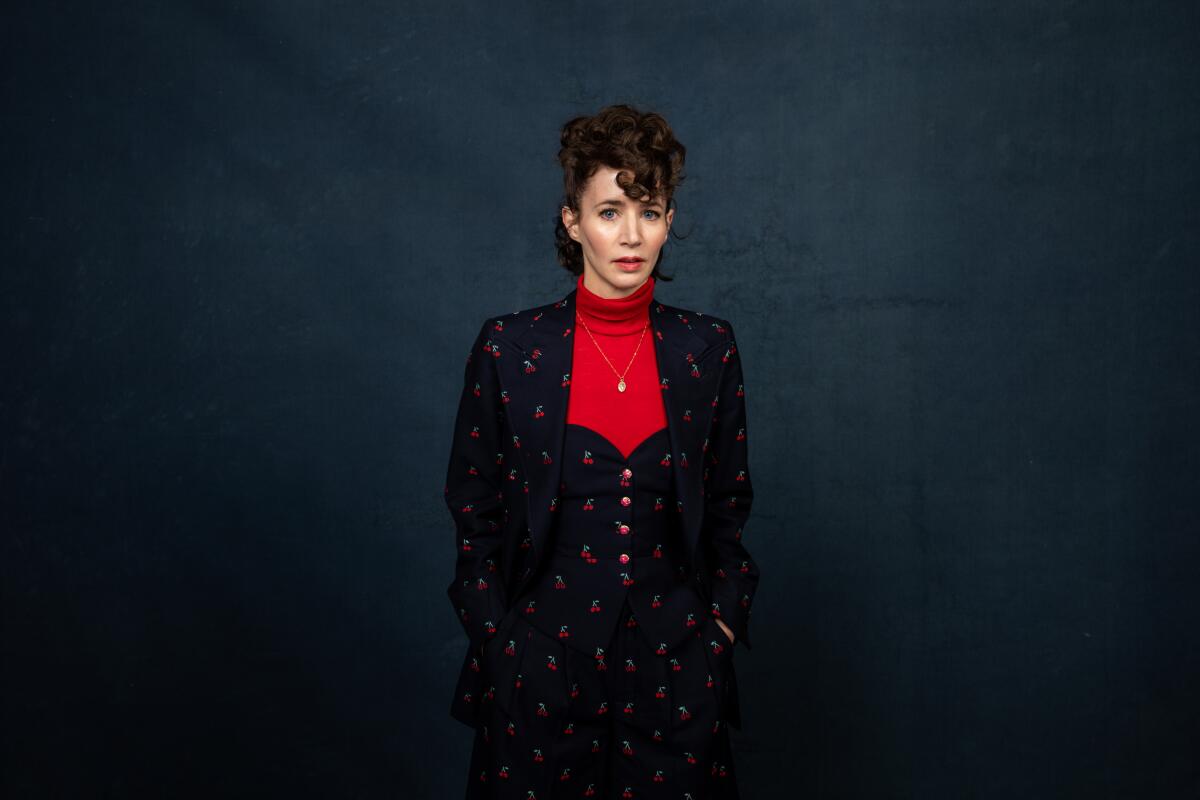You’ve never seen a movie character like Old Dolio in ‘Kajillionaire.’ Here’s how she came to be
Her name is Old Dolio Dyne. Her parents, Theresa and Robert, named her after a hobo who won the lottery in hopes that he would leave his namesake some of his money. (He did not.)
Such is the world of “Kajillionaire,” the new film written and directed by Miranda July. Old Dolio (Evan Rachel Wood) has been indoctrinated by her parents — Robert (Richard Jenkins) and Theresa (Debra Winger) — into a life of “skimming,” pulling off low-level scams, schemes and cons. After the family meets Melanie, a bubbly optician’s assistant (brought to buzzing life by Gina Rodriguez), Old Dolio finds her mind and heart opened in ways she never imagined possible — receptive to love, intimacy and a life beyond the cult-like beliefs and restrictions of her family.
The film premiered earlier this year at the Sundance Film Festival, where it was acquired by Focus Features and scheduled for a summer release. That plan was scrapped by the COVID-19 shutdown, but it’s now playing in theaters where they are open and — as part of a new release strategy adopted by Universal Pictures — will hit PVOD on Oct. 16.
As audiences discover “Kajillionaire,” they’ll meet one of the strangest and most original characters to hit the screen in some time. Awkward and introverted, Old Dolio is also startlingly tender, as she awakens to a world beyond the one she has been indoctrinated into. The Times spoke with July and Wood about the steps it took to bring Old Dolio to life.
Casting
As a longtime fan of July’s work as a filmmaker, author and fine artist, Wood was immediately keen on the project and her excitement only grew once she encountered Old Dolio on the page.
“We never get to see heroines or leading ladies that look or sound or act like her,” said Wood, a three-time nominee for both the Emmys and Golden Globes currently headlining HBO’s “Westworld.” “I had never read a script [like this] before and I’ve been reading scripts since I was 5 years old. So that to me was such a great sign and such a rare thing these days. I was excited that people were still making films like this.”
We never get to see heroines or leading ladies that look or sound or act like her.
— Evan Rachel Wood on the character of Old Dolio in Miranda July’s ‘Kajillionaire’
July recalled seeing Wood in Todd Haynes’ 2011 miniseries adaptation of “Mildred Pierce” for HBO, in which Wood played the bratty daughter to Kate Winslet’s long-suffering title character. Though it’s a very different kind of mother-daughter dynamic than the one in “Kajillionaire,” July noted something special in Wood’s performance.
“Of course I’d seen her in a lot of things, but purely as a director, I just remember watching that and being like, ‘Wow, what I wouldn’t give to have that at my disposal,’” said July. ”But I had no idea what she was really like. She’s kind of a shapeshifter, and I was pretty honest with her about that when we first met. She’s a true actress. I couldn’t tell [who she really is] — and I sort of actually stayed like that. She’s still pretty mysterious to me, but she did kind of give me these clues, ‘Oh, you don’t have to worry about that. There’s plenty of Old Dolio here.’”
Movement and voice
The two began workshopping the character, sometimes role-playing therapy sessions. July would gradually strip away Wood’s use of language, then gestures — “Evan actually has very eloquent hands,” said July — until the actress was left only with glances, expressions, guttural noises and occasionally lashing out in rage with her whole body as a means of communication.
For Wood, these exercises had unexpected payoffs once shooting began.
“On set she would yell things out to me like, ‘proud lion,’ and I would know what she meant because we based some of Old Dolio’s mannerisms — the air about her was a proud lion,” said Wood. “That was our reference, it was things like that. And right down to how I hold my hands and put my hair behind my ears. I think I practiced on how I would put my hair behind my ears hundreds of times. Miranda is very specific about her vision and that’s why her films have their own style and tone.”
Together they also worked on a low-register voice for Old Dolio, which is lower than Wood’s public speaking voice but in fact closer to her natural voice. (It’s better for her singing voice if Wood speaks higher than her natural register.) They also devised a specific method of movement for Old Dolio — particularly how she enters a post office at the beginning of the movie to avoid being detected by security cameras, which has a callback later in the film — that is similar to the choreography of July’s performance pieces.
“The voice and the movements of Miranda have this incredible quality to her physicality that reminds me of a modern-day Peter Sellers or Charlie Chaplin,” said Wood. “It’s those subtle movements that take you slightly out of reality and make you laugh or make you cry. There’s this beautiful choreography to it, but it seems very natural.”

July herself starred in the two previous feature films she directed, 2005’s “Me and You and Everyone We Know” and 2011’s “The Future.” Yet she never saw herself in any of the roles in “Kajillionaire” and certainly not Old Dolio.
“Let’s just be honest, Evan Rachel Wood, she can do so much more than me as an actress,” said July. “I could see her more clearly than I would have been able to see myself. Of all the actors, and they were all so good, she was the one who I most felt like when I would give her notes, I barely even have to verbalize them. I sometimes felt like as long as I could think what I want, she’ll do it. And it’s not that we were so close, it’s that she’s that locked in, in sync. She’s not needing a whole intellectual story to get behind, she’s feeling it.”
The interloper
When Melanie enters into the tight-knit dynamic between Old Dolio and her parents, it is Robert and Theresa who first take a liking to her, igniting a certain jealous skepticism from their daughter for the outside interloper. Soon Old Dolio finds herself charmed by Melanie as well, and the relationship develops in ways Old Dolio never even conceived of, an affection wholly separate from her parents. July’s story never tries to define or name their relationship, but simply allows the emotions and attraction between two women to take on a life of its own.
“What I loved about it is it’s never spoken about, and as a someone who identifies as bisexual and as a queer woman, one of the things I loved about the script is [the relationship] is in the movie, but it’s not what the movie’s about,” said Wood. “And that to me is the future, and what the future needs to be. We’re not making a movie about being gay or we’re not making a movie about being a person of color. We’re just telling their stories. And so gender doesn’t really exist and sexuality doesn’t really exist in this world, or certainly in Old Dolio’s world. And that in itself is the statement.”
The origins of the character of Old Dolio came not from a dream but from the haze of being half-awake. One morning as July was just waking up she had a vision of three people — two women with long, straight hair and a man — and instead of going back to sleep she grabbed her phone and started taking notes. Her first photo reference was of a woman with long parted hair. She was trying to fix in her mind the image that would become Old Dolio.
“She sat at this crossroads for me,” said July, “like for my own history, between a long-haired butch woman, which is like the kind of woman that I would be attracted to — like Heath Ledger in ‘Brokeback Mountain’ if they were a woman, the strong, silent type. Not good at talking about their feelings, but so appealing. And that type of character is not going to be self-aware or politicized or self-knowing, not about her queerness.”
The look
Working with costume designer Jennifer Johnson, July and Wood collaborated on Old Dolio’s clothes. The looks had to mix a certain functionality — at any moment she could reconfigure what she was wearing to assume a different persona as needed for a job — along with an almost incidental sense of style.
“Semi-consciously or accidentally, she was radiating something that someone like Melanie could interpret. It’s no mistake that it’s when Melanie sees her and says, ‘I like your track suit.’ That’s the beginning of Melanie falling for her, there is a code there,” said July.
“There is a kind of hip-hop by way of Balenciaga. There’s a whole world of fashion references that can also make Old Dolio cool. So I was trying to walk several different lines, all while having it feel right to her, without her knowing any of the cultural references. Because then it was also a way to have a queer character without having to make a movie about that.”
The perspective
While it may seem to survey an oddball world, there is something deeply personal about the film for July. She is married to “20th Century Women” filmmaker Mike Mills, and “Kajillionaire” is the first feature film July has made since they had a child. The film’s explorations of what makes a family and what gets handed down from one generation to the next were things that were very much on her mind as she was writing the screenplay, even as she tried to avoid direct connections to her own life.
“I’m the kind of writer who if I become too autobiographical, everything just dies. But that said, I’m feeling a lot and have a lot to say. This movie is the first one I’ve been both a daughter and a mother for as I was writing,” said July. “And I think when you’re only a daughter, no matter how old you are, parenting is like the sky above or God or something — you can only, like, shake your fist at it. It’s so complete what was done to you. Whereas when you’re on the other side of it, it’s like a series of decisions you made during a weird time in your life. A combination of maybe a parenting class and some things you were struggling with.”
In July’s idiosyncratic style, “Kajillionaire” is surreal and even a bit silly, like the pink bubbles Old Dolio and her parents scrape off the walls of the abandoned office space where they live, but there is also something deeply felt and directly emotional about it too. Old Dolio comes to realize there is more to life than just barely getting by.
“Living is a big deal. Like, you do want to really be here. You’d feel so robbed if you just skimmed,” said July. “And, yes, it’s all very heightened, but I do relate to that. And I do think we all survive our childhoods — even the good ones — and then start anew, start a totally different life from the one that was described to us.”
More to Read
Only good movies
Get the Indie Focus newsletter, Mark Olsen's weekly guide to the world of cinema.
You may occasionally receive promotional content from the Los Angeles Times.











